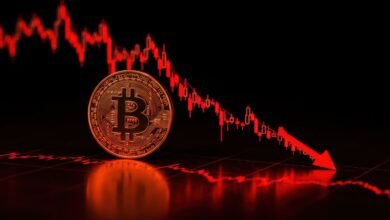Jerome Powell’s Remarks and Their Effects on the Crypto Sphere

Imagine standing on the precipice of economic change—this is where we currently find ourselves following Federal Reserve Chair Jerome Powell’s latest address. The statements made weave a narrative of hope intertwined with caution, particularly in the realm of inflation control. While Powell is optimistic about progress, the shadows cast by persistent external stresses, such as tariffs, complicate the overarching financial picture. Investors, both seasoned and new, are adjusting their strategies, keenly searching for signs of stability in this tumultuous environment.
The Dual Edges of Inflation and External Factors
Powell’s remarks on inflation are both enlightening and daunting. Presently, the core PCE price index sits at 2.9%, marking a noteworthy movement towards stability. Yet, in a stark warning, he underscored that despite these improvements, external forces—especially tariff-related tensions—threaten the Fed’s aspiration to maintain a steady 2% inflation rate. This delicate balancing act highlights the instability and interdependence that define our current economic reality, sending ripples of concern throughout the financial community regarding the fate of fiat currencies.
Employment Dynamics and the Fed’s Pragmatic Stance
As the workforce landscape shifts, new signs of a potential slowdown are becoming evident. Powell pointed to a noteworthy decrease in hiring and a reduction in job openings, paired with tempered wage growth. “There is no risk-free path,” he stated, underscoring the Federal Reserve’s imperative to remain adaptable. By taking a “meeting by meeting” stance, the Fed can respond nimbly to fluctuating economic indicators. This adaptability resonates particularly well with the crypto sector, where market sentiment remains notoriously capricious and reactionary.
Market Responses: A Cautiously Optimistic Outlook for Crypto
In the wake of Powell’s address, financial markets experienced a tentative wave of optimism. The dollar experienced a minor dip, Treasury yields declined, and equity futures saw slight upswings. Traders interpreted the neutral tone of Powell’s speech as dovish, yet they remain vigilant about what lies ahead. Within the cryptocurrency domain, prominent assets like Bitcoin and Ethereum saw slight gains, suggesting a rekindled appetite for risk among investors. Nonetheless, Powell’s caution about the potential resurgence of inflation looms heavy, a stark reminder of the inherent volatility that characterizes today’s markets.
The Influence of Policy on Crypto Liquidity
The implications of Powell’s comments stretch deep into the liquidity frameworks governing digital asset markets. With whispers of quantitative tightening drawing to a close, anticipation of more favorable liquidity conditions is sparking excitement. This is paramount for startups operating within the Web3 framework, which rely heavily on a seamless integration of crypto and fiat systems for success. However, it’s vital to navigate this enthusiastic terrain cautiously, as geopolitical tensions and unforeseen economic shocks can easily derail progress.
The Capsized Tie Between Tariffs and Inflation
The complex interplay between tariffs and inflation adds a layer of unpredictability that has profound implications for liquidity and the efficiency of crypto-to-fiat transactions. Research indicates that adept navigation through these turbulent waters demands sophisticated strategic frameworks, especially for players in the decentralized finance space. With tariffs influencing pricing and liquidity movements, crypto startups may need to recalibrate their strategies, forging stronger linkages with established financial systems. Here, innovation meets necessity, as businesses race to safeguard their futures against external economic pressures.
Conclusion
Jerome Powell’s recent address signals a watershed moment for both traditional and digital asset markets, highlighting a shift from aggressive tightening towards a more measured and adaptable policy approach. While optimism flourishes amid improving liquidity prospects for cryptocurrencies, the specter of external influences—like tariffs—remains ever-present. The ongoing clash between the ambitions of decentralized finance and the practicalities of operating within established fiat frameworks signals that Web3 entrepreneurs must approach this evolving landscape with foresight and strategy. As the Federal Reserve navigates this intricate economic maze, the dialogue emerging from these events will indelibly shape the strategies and expectations of all stakeholders moving forward. It’s a delicate equilibrium worth observing, where both risk and opportunity loom large.






